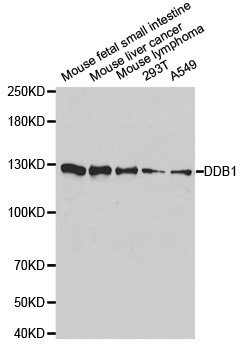
The image on the left is immunohistochemistry of paraffin-embedded Human cervical cancer tissue using CSB-PA056628(DDB1 Antibody) at dilution 1/5, on the right is treated with synthetic peptide. (Original magnification: x200)
DDB1 Antibody
CSB-PA056628
ApplicationsWestern Blot, ELISA, ImmunoHistoChemistry
Product group Antibodies
ReactivityHuman, Mouse, Rat
TargetDDB1
Overview
- SupplierCusabio
- Product NameDDB1 Antibody
- Delivery Days Customer20
- ApplicationsWestern Blot, ELISA, ImmunoHistoChemistry
- CertificationResearch Use Only
- ClonalityPolyclonal
- ConjugateUnconjugated
- Gene ID1642
- Target nameDDB1
- Target descriptiondamage specific DNA binding protein 1
- Target synonymsDDBA, UV-DDB1, WHIKERS, XAP1, XPCE, XPE, XPE-BF, DNA damage-binding protein 1, DDB p127 subunit, DNA damage-binding protein a, HBV X-associated protein 1, UV-DDB 1, UV-damaged DNA-binding factor, UV-damaged DNA-binding protein 1, XAP-1, XPE-binding factor, damage-specific DNA binding protein 1, 127kDa, xeroderma pigmentosum group E-complementing protein
- HostRabbit
- IsotypeIgG
- Protein IDQ16531
- Protein NameDNA damage-binding protein 1
- Scientific DescriptionThe protein encoded by this gene is the large subunit (p127) of the heterodimeric DNA damage-binding (DDB) complex while another protein (p48) forms the small subunit. This protein complex functions in nucleotide-excision repair and binds to DNA following UV damage. Defective activity of this complex causes the repair defect in patients with xeroderma pigmentosum complementation group E (XPE) - an autosomal recessive disorder characterized by photosensitivity and early onset of carcinomas. However, it remains for mutation analysis to demonstrate whether the defect in XPE patients is in this gene or the gene encoding the small subunit. In addition, Best vitelliform mascular dystrophy is mapped to the same region as this gene on 11q, but no sequence alternations of this gene are demonstrated in Best disease patients. The protein encoded by this gene also functions as an adaptor molecule for the cullin 4 (CUL4) ubiquitin E3 ligase complex by facilitating the binding of substrates to this complex and the ubiquitination of proteins.
- ReactivityHuman, Mouse, Rat
- Storage Instruction-20°C or -80°C
- UNSPSC41116161







